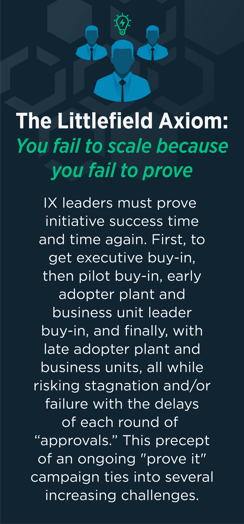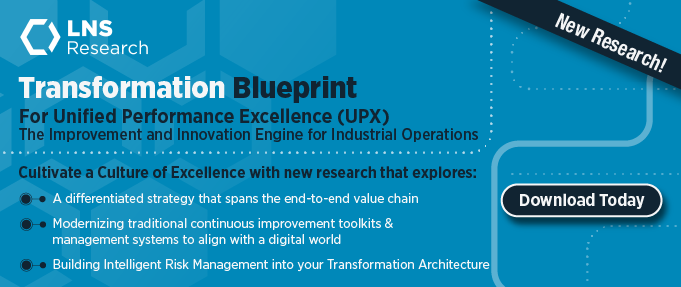We've all seen the headline, "70% of Transformation Projects Fail." This staggering statistic is based on years of LNS Research's work in Industrial Transformation (IX) and is consistent with what other firms and academia have found. To reverse this trend and make real improvements, business leaders need to understand why we're seeing such dismal results.
 After reviewing all the research from LNS Research's recent State of IX Tech study and focusing on the root causes of failure in transformation initiatives, the evidence suggests that the breakdowns are not as much with technology or processes but with people, specifically leaders.
After reviewing all the research from LNS Research's recent State of IX Tech study and focusing on the root causes of failure in transformation initiatives, the evidence suggests that the breakdowns are not as much with technology or processes but with people, specifically leaders.
The title of this blog is one of the most famous and misquoted movie lines in Hollywood history: "What we've got here…is failure to communicate from the 1967 classic "Cool Hand Luke," starring Paul Newman.
A "failure to communicate" echoes through many top challenges cited by the 321 manufacturing leaders who participated in our State of IX Tech research.%20Program.png?width=1200&height=1034&name=Top%20Challenges%20in%20Implementing%20an%20Industrial%20Transformation%20(IX)%20Program.png)
The above chart lists the top nine responses with YoY changes from our 2019, 2021, and most recent 2023 survey data. The LNS Research team has written extensively on the number one reported challenge (hiring/skilled workforce), so if you need to dive deep into how to address the challenges of the skilled labor shortage, please see the LNS Research blog page for posts from my fellow Analysts Allison Kuhn and James Wells.
In this blog, I want to focus on a few of the other top challenges where company executives are failing, according to the data:
-
-
-
Top Challenge #3: Scaling Quick Wins
A YoY (2021 – 2023) jump of 125% is significant and reflects the challenges in taking a successful pilot or lighthouse project and thinking the case is proven on a data set of one and you can simply mirror the approach at every site
-
Top Challenge #5: Lack of Executive Support
Trending in the wrong direction with a 100%+ increase over five years (2019-2023), and must be understood as a much larger issue than budget. As we will discover in this blog, it's much more about time and effective communication
-
Top Challenge #6: Company Culture
Steady at 21-22% and best summarized from our interviews as resistance to change and places into context why the big consulting and SI firms make so much money from their change management practices
-
Top Challenge #7: Lack of buy-in from Frontline Workforce and Plant Management
This is the most concerning trend, with a 100% increase from 2021-2023. Generally identified through interviews as skepticism fueled by previous failed IT projects and "top-down dictates" from a command-and-control management style. Company size plays a role, especially in large companies ($1B+ in revenue).

Well-intentioned leaders armed with visions of increased efficiency and productivity charge ahead with Digital/Industrial Transformation (IX) plans. However, skilled workers and plant managers, the frontline workforce that keeps the operation moving, often feel left behind, unheard, and, ultimately, resistant. As a result, skepticism increases and becomes the invisible barrier hindering real progress.
Common Root Causes of Communication Breakdowns
Based on years of survey data and our direct work supporting IX initiatives, here are some of the most common communication mistakes leaders have made:
-
-
-
One and Done: Leaders try to "cut and paste" a successful pilot, failing to recognize Matthew Littlefield's axiom, "You fail to scale because you fail to prove." Our research says you have to prove over and over again to many different audiences.
-
Top-Down Dictates: Leaders assume Transformation plans can unfold like military campaigns, with directives issued from above and little input from those on the ground. Frontline workers, the foot soldiers of operations and maintenance, have not been given an understanding of the "why" behind the change, breeding suspicion and fear.
-
Phoning it In: Leaders relying on a few company-wide emails, an all-hands call, or a well-produced video to announce and explain how this transformation project "will bring step-change improvements and efficiencies to the business" – justifying to themselves that their busy schedule mandates the impersonal approach or that the "number of sites in our enterprise" prevents them from going to the plants and making the case face-to-face with the people most impacted.
-
Silicon Jargon: Leaders speak the language of "synergy," or "digital," and "cloud-based solutions," while workers navigate the tangible world of production, wrenches, and gears. This language barrier creates a chasm, leaving workers feeling excluded and their valuable insights unheard.
-
Fear of the Unknown: Leaders, without providing context, use words like automation and the even scarier word "autonomous," which are feared to mean job losses. Leaders try to assure the workforce that the transformation initiative is not about replacing humans with robots, but trust remains elusive without clear, transparent communication.
Disrupted Routines: Leaders fail to recognize and acknowledge change, even positive change, and disrupt established processes. Decades of honed skills and problem-solving methods are suddenly deemed "inefficient." Without adequately acknowledging the contributions of the current experienced approach, "digitizing" can be misinterpreted as disrespecting these ingrained routines, which fuels resentment and resistance.
Root Cause Analysis
Breaking down the Littlefield axiom, insights come from our many case studies where transformation projects fall into what LNS Research calls the Transformation Chasm. "You fail to scale because you fail to prove" over and over again to many different audiences means an ongoing communications campaign where IX leaders  must get executive buy-in, pilot buy-in, early adopter plant, and business unit leader buy-in, then late adopter plant and business units. It is during these later stages, when plants are not on the rollout schedule until year two or year three, that transformation projects stall and/or fail. This precept of an ongoing "prove it" campaign ties to two of the increasing challenges we see in the data:
must get executive buy-in, pilot buy-in, early adopter plant, and business unit leader buy-in, then late adopter plant and business units. It is during these later stages, when plants are not on the rollout schedule until year two or year three, that transformation projects stall and/or fail. This precept of an ongoing "prove it" campaign ties to two of the increasing challenges we see in the data:
The trend we are seeing is that Industrial Transformation (IX) Leaders, those responsible for IT, OT, and DT in manufacturing, are losing momentum, influence, and power at many companies. Often, this is because the role and team were created 3-5 years ago, and they received a significant budget allocation to execute the transformation strategy. However, now the money is spent, and companies are trying to push the skills, responsibilities, and ownership down into the business…and they're struggling.
Leaders Need to Ask Themselves…
Who is responsible for the organization's belief that there is a lack of executive support? Who is responsible for establishing and nurturing a positive company culture that embraces continuous improvement? Who is responsible for the lack of buy-in and skepticism from frontline workers and plant management? You know the answer. So…
Pivot Because Your Current Strategy Is Not Working
Hey, leaders, you're not too busy. You do have the time. A failed transformation project will cost your business far more than the time and expense of listening, seeing, and gaining a greater understanding of a day in the life of your most precious and important resource.
As my friend and Digital Transformation leader Paul Boris says, "All failures are failures of leadership."
Recommendations for Transformation Leaders
Undercover Boss
I started this blog with a Hollywood reference, so let's end with one - steal a page from the reality TV show Undercover Boss. No entourage, no fuss, just you in some dirty coveralls and a hard hat out on the plant floor listening, learning, interacting, understanding, building relationships, and, most importantly, credibility. And if someone on your staff tells you that spending quality time with the frontline workforce is a waste of time and money, terminate them immediately.
Transparency
Your communication plan for the transformation initiative needs to include a clear set of metrics where the organization understands what is being measured, how it is being measured, and the frequency it is being measured. Transparency means that the data is available to everyone, updated regularly, and displayed for all employees to see. A key to winning adoption, culture change, and scale is evidence that the transformation initiative is delivering value and business improvements. Critical to your ongoing "prove it" campaign.
Stay Engaged
In some of the larger enterprises LNS Research works with, the IX timeline to scale across all their plants is 2-3 years or longer. Successful transformation initiatives are exemplified by the leadership team, which is just as supportive and engaged as the final plant goes live as they were when the project was launched at the first plant.
In Conclusion
When it comes to transformation and adoption, leaders must close the loop. They must confidently and repeatedly remind the organization (proactive communication) that transforming company operations will require change and that the overall system and company will benefit. This is in sharp contrast to the "failure to communicate" assumptions that a few emails or a companywide call is all that is required. Prepare people with the knowledge that some jobs and tools will get better immediately, but some with legacy purpose-built tools may, in the short term, lose some desired features and functions. Acknowledge that, make sure you understand when this is happening, and close the loop on why with those impacted. In my experience, this approach turns skeptics into champions.
